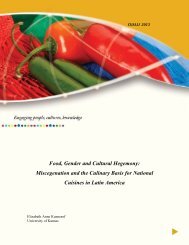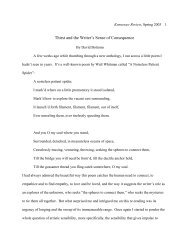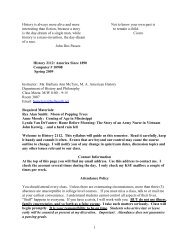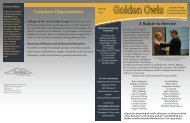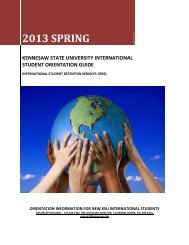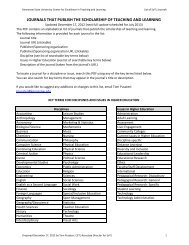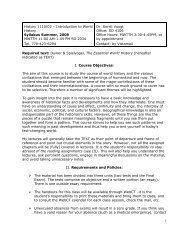TR 2:00 PM - Kennesaw State University
TR 2:00 PM - Kennesaw State University
TR 2:00 PM - Kennesaw State University
You also want an ePaper? Increase the reach of your titles
YUMPU automatically turns print PDFs into web optimized ePapers that Google loves.
1<br />
History 2270/02 - Spring 2012<br />
Introduction to Themes in History – CRN810185<br />
<strong>TR</strong> 2:<strong>00</strong> - 3:15, SO 3032<br />
Instructor: Dr. Elsa A. Nystrom<br />
Office: Social Science Building - 4122<br />
Office Hours: <strong>TR</strong> – 9:<strong>00</strong> – 12:30, 3:30 – 4:30, or by appointment.<br />
Office Phone: 770 - 423-6149 (voice mail number)<br />
History Dept.: 770 -423-6294<br />
E-mail- enystrom@kennesaw.edu<br />
A NOTE ABOUT VISTA<br />
Vista is an important part of our course structure, Please expect emails about upcoming classes as well as<br />
uploaded documents for you to read. If I can’t make a class, I will contact you through VISTA so please<br />
check your messages regularly. I will also post assignment due dates on Vista calendar.<br />
Text:<br />
Hoffer, Peter Charles. Past Imperfect; Facts Fictions Fraud—American History from Bancroft and<br />
Parkman to Ambrose, Bellisles, Ellis and Goodwin.<br />
A Note about the textbooks:<br />
The Hoffer book deals with historiography and current trends in writing American history. It will give you<br />
some insights regarding the subjectivity of history and show that often historians have more than one<br />
reason for writing about a particular period of history. We will use the web for input on proper grammar,<br />
punctuation, footnotes and bibliography.<br />
The overall theme in this class is history and mystery in 19 th and 20 th century North America<br />
extending outwards to the British Empire because of its influence on America at this time. We will<br />
look at fiction and non-fiction written during this period. Some assigned material deals with a mystery as<br />
deduction and problem solving is a part of the historian’s craft. The class will be divided between<br />
discussion about method and analysis, discussion of historiography and historians, and discussion of<br />
the results of your assignments as well as presentations to the class.<br />
Course Objectives<br />
1. To understand the meaning of history and how historians research and interpret historical topics.<br />
2. To learn about the variety of sources that can be used in the study of local history.<br />
3. To learn the proper techniques of documenting historical sources.<br />
4. To evaluate primary sources and analyze secondary source<br />
5. To gain a working knowledge of the use of different types of primary and secondary source materials<br />
in a problem solving situation.<br />
6. To learn how to write a variety of papers with the style and methodology used by historians including<br />
analysis, critique, evaluation and essay.<br />
Course Description<br />
The purpose of History 2270 is to teach you to think research and write history as a professional historian<br />
does. The skills and insights you learn will be useful for all history majors, history teachers at all levels and<br />
in the real world as well. Considerable class time will be devoted to a discussion of the methods of<br />
historical interpretation and the different ways in which historians have viewed the past. Class time will<br />
also be spent on discussion of the proper ways to footnote a paper and prepare a bibliography using the<br />
format detailed in the Chicago Manual of Style (available in the library) We will use two online resources<br />
the Historian’s Toolbox http://guides.library.fullerton.edu/historians_toolbox/index.html
and Son of Citation Machine http://citationmachine.net/leftpanel.php?reqstyleid=10&more= to provide<br />
assistance in learning the fundamentals of formatting and research.<br />
Written assignments include an analysis of newspaper accounts and an evaluation of textbook chapters on<br />
the reconstruction era in the United <strong>State</strong>s<br />
You will also get to choose from a variety of case studies based on primary sources dealing with<br />
mysterious events during the time frame of the class to develop a Power Point argument providing your<br />
interpretation of what actually happened using the skills you have learned in the class..<br />
These case studies are found on the following website:<br />
http://www.canadianmysteries.ca/mysteries/indexen.html I will add another website link shortly.<br />
If you have any questions don’t hesitate to email me or stop by my office. Please don’t wait until the<br />
last minute if there is a problem. I am in my office all day Tuesday and Thursday unless I have a<br />
meeting or am in class.<br />
You must adhere to the time table set out in the syllabus unless you have major problems.<br />
Assignments are due on the date listed in the syllabus. If your assignment is not turned in on time,<br />
you will either lose points or get a zero for the assignment.<br />
Academic Honesty:<br />
No student shall receive, attempt to receive, knowingly give or attempt to give<br />
unauthorized assistance in the preparation of any work required to be submitted for credit<br />
(including examinations, laboratory reports, essays, themes, term papers, etc.). Unless<br />
specifically authorized, the presence and/or use of electronic devices during an<br />
examination, quiz, or other class assignment is considered cheating. Engaging in any<br />
behavior that a professor prohibits as academic misconduct in the syllabus or in class<br />
discussion is cheating. When direct quotations are used, they should be indicated, and<br />
when the ideas, theories, data, figures, graphs, programs, electronic based information or<br />
illustrations of someone other than the student are incorporated into a paper or used in a<br />
project, they should be duly acknowledged. No student may submit the same, or<br />
substantially the same, paper or other assignment for credit in more than one class<br />
without the prior permission of the current professor(s).<br />
Any infraction will be handled according to KSU Policy in the KSU Student Handbook.<br />
.<br />
Turnitin<br />
All students are required to submit their written assignments to Turnitin.com, a website that checks for<br />
plagiarized work. It also can help you identify your sources and provide feed back regarding correct citing<br />
of material. The registration process for Turnitin.com will be explained in the first week of class.<br />
Grading System<br />
Grades will be based on the following scale: A 90-1<strong>00</strong>, B 80-89, C 70-79, D 60-69 and F 0-60.<br />
The final grade will be an average of the following parts:<br />
1. Classroom. Participation in Weekly Lecture/Discussions – 10 %<br />
2. Newspaper article comparison paper – 20%<br />
3. Textbook comparison /review – 20%<br />
4. Power Point Presentation and bibliography – 40%<br />
5. Minor 50 word writing assignments – 10%<br />
2
* Assignments are due on date listed on syllabus. Late papers will decline in value rapidly. No papers<br />
will be accepted after the last day of class unless you have a very serious reason for not completing<br />
your work.<br />
There is no final exam in this class.<br />
Attendance Policy<br />
Students are expected to attend class. We will take attendance every class. Your grade will reflect missed<br />
classes. NO cell phones on in class please and computers only for notes if needed NOT web surfing or face<br />
booking.<br />
Incomplete Grade<br />
At semester's end an incomplete will be considered only if you have completed 75% of the class<br />
requirements, only if you have a grade of C or better and only if you can prove that some emergency<br />
prevents you from completing all the course requirements on time.<br />
Class Calendar<br />
1 Tuesday, January 10<br />
Introduction to the course.<br />
3<br />
2 Thursday January 12<br />
Select topic for newspaper article assignment from list that follows. Discuss directions<br />
for assignment. Assignment due February 2.<br />
Wreck of the Steamship Arctic, 1854<br />
The Great Chicago Fire, 1871<br />
The Eruption of the Krakatoa Volcano, 1883<br />
President James Garfield Assassination and Death, 1881<br />
Assassination of President McKinley<br />
Sitting Bull surrenders, July 20, 1881<br />
The Johnstown Flood, 1889<br />
Jesse James Shot, 1882<br />
The Galveston TX Hurricane, 19<strong>00</strong><br />
The Peshtigo WS Fire, 1871<br />
The Boxer Rebellion in China, 19<strong>00</strong><br />
Sinking of the Maine<br />
Italy’s King assassinated, 19<strong>00</strong><br />
Triangle Shirtwaist Factory Fire, March 25, 1911<br />
San Francisco Fire and Earthquake, 1906<br />
Marconi transmits radio signal across the Atlantic, 19<strong>00</strong><br />
Wilbur and Orville Wright first powered flight, 1903<br />
Lindberg Flight across the Atlantic, 1927<br />
Tomb of King Tut Found, 1922<br />
Okeechobee Hurricane, Sept 16, 1928<br />
Sinking of the Lusitania, May 7, 1915.<br />
Newspaper Article Review Assignment Directions<br />
After you get your topic, you must locate an article on your event in four different<br />
newspapers of the time. Before you read your articles, look up the event in Wikipedia to<br />
see what current thinking is on what happened. Then read your articles and write a brief<br />
account of your findings. Was the information similar or the same? Did it vary by region<br />
or type of newspaper? What was stressed in the articles? Was anything omitted or
4<br />
perhaps misleading? How did these newspaper accounts compare with the modern<br />
account of the event? Please include printouts of your articles with your paper.<br />
3 Tuesday January 17<br />
Virtual Tour of Sturgis Library resources related to this class, 11:<strong>00</strong> AM . Meet in<br />
classroom. Afterwards, write 50 word sentence stating how useful you found the virtual<br />
tour.<br />
Due Thursday January 19.<br />
4 Thursday January 19<br />
Read and discuss Past Imperfect, pg 1 – 16. Write a 50 word sentence that<br />
summarizes what Hoffer says about the study of history. Be prepared to read yours<br />
before you hand it in next Tuesday, the 25th. I am not kidding about the 50 word<br />
limit; you will find this is not as easy to do as you might think. Scoring Rubric is<br />
posted on Vista<br />
5 Tuesday January 24<br />
Read and discuss the Sherlock Holmes adventure, The Sign of the Four by Sir Arthur Conan<br />
Doyle in its Victorian context ( follow this link on Project Gutenberg<br />
http://www.gutenberg.org/files/2097/2097-h/2097-h.htm .). Write a 50 word summary of the<br />
story. Be prepared to read yours to the class. Again the idea here is brevity; anything over 50<br />
words will be penalized. Due January 26.<br />
6 Thursday, January 26<br />
Introduction to Historian’s Toolbox and Citation Machine. Discussion of annotation of an article.<br />
50 word Sherlock Holmes assignment due. Discuss.<br />
7 Tuesday, January 31<br />
Read and discuss Past Imperfect, Chapter 1; Discussion of formatting and writing styles.<br />
Read and discuss Past Imperfect, Professions of History.<br />
8 Thursday, February 2<br />
Newspaper assignment due; discuss findings<br />
9 Tuesday February7<br />
Tour of Rare Book Room; meet in library lower level at Rare Book Room.<br />
After tour write 50 word sentence detailing the importance of the Rare Book Room for KSU<br />
students , faculty and alumni.<br />
10 Thursday February 9<br />
Discussion of textbook review assignment;. Read and discuss Past Imperfect, Chapter 3.<br />
Textbook Review Assignment Directions<br />
I have selected chapters from four different textbooks for you to review and analyze. One chapter<br />
dates from 1898 although it was revised in 1910. One is from 1920 and the other two are popular<br />
current survey texts. The chapters I have chosen deal with Reconstruction although the earlier<br />
texts, written fairly close to the event, do not have a chapter strictly dedicated to Reconstruction<br />
although they have some relation to the modern texts. The chapters come from books written by
Julian Hawthorne, 1898, Emerson Davis Fite, 1923, Alan Brinkley and Howard Zinn, both current<br />
texts.<br />
One might expect to find similarities between the two earlier books and between the two later ones<br />
and a few startling differences between the earlier and later books but this may not be the case. As<br />
you read try to answer the following questions. Before you begin, you will find it very helpful to<br />
learn something about each author, to place him in the proper school of historical interpretation.<br />
What is the thesis of each chapter and is the thesis different in each? Is there a parallel in coverage<br />
and analysis in any of the four? Do any have a consensus regarding the issues of Reconstruction?<br />
What kind of events does each stress? What important historical figures are mentioned? Who and<br />
what do they omit? Obviously the first two will leave out some of the issues considered important<br />
in the later ones given the changing perspectives that time brings to historical events. Where does<br />
each author fit in regard to historiographical interpretation of his work. Finally which text do you<br />
like the best? Why? Do any of these chapters provide an unbiased view of the past? Why or why<br />
not? Finally, often books tell us more about the culture, values and beliefs of the time in which<br />
they were written. Do you see any evidence of this in your four chapters? Be specific. Your<br />
assignment should be double spaced and approximately 5 to 8 pages in length. You will be graded<br />
on organization, content and grammar.<br />
5<br />
11 Tuesday, February 14<br />
Selection of website for final Power point assignment and discussion of assignment. See<br />
Great Mysteries in Canadian History website.<br />
http://www.canadianmysteries.ca/mysteries/indexen.html<br />
Instructions for this assignment are posted on Vista.<br />
Rare Book Room assignment due today<br />
12 Thursday, February 16<br />
Read and discuss Past Imperfect, Chapter 4.<br />
13 Tuesday, February 21<br />
Discussion on the mechanics of writing and research.<br />
14 Thursday February 23<br />
Catch –up if needed.<br />
15 Tuesday February28<br />
Read and discuss Past Imperfect, Chapter 5.<br />
16 Thursday March 1<br />
Discuss research progress for PPT, textbook and textbook chapter assignment.<br />
NO Class this week(March 3 - 9) - Spring Break<br />
17 Tuesday March 13<br />
Creation of bibliography, annotation and other elements of formatting in Turabian or Chicago<br />
style. Put together a brief bibliography for your research topic including a variety of sources;<br />
books, articles, web pages etc.<br />
18 Thursday March 15<br />
Discuss your bibliography in class, bring copy to put on screen.<br />
19 Tuesday March 20<br />
Textbook chapter review assignment due; discuss findings.
6<br />
20 Thursday March 22<br />
Discussion overflow if needed. Read and discuss Past Imperfect Chapter 7.<br />
21 Tuesday March 27<br />
Read and discuss Past Imperfect Chapter 8.<br />
22 Thursday March 29<br />
Footnoting, Footnoting, Footnoting and solving the mysteries of an annotated bibliography.<br />
23 Tuesday April 3<br />
Read and discuss Past Imperfect, the future of the past.<br />
24 Thursday April 5<br />
Power Point Presentations begin..<br />
25 Tuesday April 10<br />
Power Point presentations continue.<br />
26 Thursday April 12<br />
Power Point presentations continue<br />
27 Tuesday, April 17<br />
Presentations continue<br />
28 Thursday April 19<br />
Presentations continue<br />
29 Tuesday April 24<br />
Presentations continue<br />
30 Thursday April 26<br />
Presentations continue<br />
.<br />
*** No final exam<br />
Students must hand in a print out of their Power Point presentation and an annotated bibliography listing<br />
sources used.



